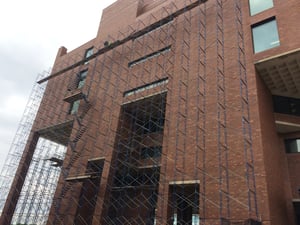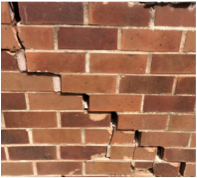This past week my organization, GBMP, moved from our home of twenty years at the Boston campus of the University of Massachusetts. The UMB College of Management needed more space and so did we, so we relocated to quarters that will afford room for our growing staff and dedicated training space for our customers. The occasion has given me inspiration for the following post:
 I was walking across the UMass Boston campus last week, reminiscing about the two decades that GBMP has called it home. Glancing toward the twelve-story Healey library, I viewed a familiar spectacle: Scaffolding reaching nearly to the top had been erected on the south face of the building. Workers at the site explained that the top twenty rows of bricks were loose and at risk of falling. I thought of the biblical metaphor of the house “built on sand,” or more accurately in this case the library built on an old landfill. At some time in 1880’s the city of Boston, like many municipalities, determined it would be good idea to dump its prodigious amounts of trash at its periphery, which in this case was a cow pasture at the border of the city and its scenic harbor. The area nearby, a neighborhood known as Columbia Point, gradually became a mountain of garbage, notorious for its stench and visual pollution. By the 1960s, community residents from Columbia Point hired F. Lee Bailey to help get the city dump permanently closed by the Massachusetts Supreme Court. It’s hard to understand today why the dump site, literally a monument to short-term thinking, was chosen in the first place.
I was walking across the UMass Boston campus last week, reminiscing about the two decades that GBMP has called it home. Glancing toward the twelve-story Healey library, I viewed a familiar spectacle: Scaffolding reaching nearly to the top had been erected on the south face of the building. Workers at the site explained that the top twenty rows of bricks were loose and at risk of falling. I thought of the biblical metaphor of the house “built on sand,” or more accurately in this case the library built on an old landfill. At some time in 1880’s the city of Boston, like many municipalities, determined it would be good idea to dump its prodigious amounts of trash at its periphery, which in this case was a cow pasture at the border of the city and its scenic harbor. The area nearby, a neighborhood known as Columbia Point, gradually became a mountain of garbage, notorious for its stench and visual pollution. By the 1960s, community residents from Columbia Point hired F. Lee Bailey to help get the city dump permanently closed by the Massachusetts Supreme Court. It’s hard to understand today why the dump site, literally a monument to short-term thinking, was chosen in the first place.
 Ten years after the dump was closed, the site was selected by Boston State College (now UMass Boston) as its new home. The campus, which opened in 1974, created a striking skyline against the backdrop of the majestic Boston Harbor, and appeared to be a terrific re-purposing of the former blighted site. Beneath the brick facade however there lurked a half-century of shrinking landfill. Perhaps because the state of the art for civil engineering was not sufficiently advanced in the 1970’s or perhaps because budget controls caused corners to be cut in the design of footings for the new campus, the Healey library began to sink; imperceptibly at first, but eventually in ways that required constant monitoring and repair. For whatever reason, it can be said that insufficient consideration had been given to the design of the building’s foundation. By the 1990’s the motion of the facade caused bricks to become dislodged and sometimes fall, and by 2006 the parking garage beneath the library was closed for safety reasons. Finally, this year began the perennial re-facing of the library’s facade, the event that inspired this post. Rumor has it that eventually the library must be replaced altogether.
Ten years after the dump was closed, the site was selected by Boston State College (now UMass Boston) as its new home. The campus, which opened in 1974, created a striking skyline against the backdrop of the majestic Boston Harbor, and appeared to be a terrific re-purposing of the former blighted site. Beneath the brick facade however there lurked a half-century of shrinking landfill. Perhaps because the state of the art for civil engineering was not sufficiently advanced in the 1970’s or perhaps because budget controls caused corners to be cut in the design of footings for the new campus, the Healey library began to sink; imperceptibly at first, but eventually in ways that required constant monitoring and repair. For whatever reason, it can be said that insufficient consideration had been given to the design of the building’s foundation. By the 1990’s the motion of the facade caused bricks to become dislodged and sometimes fall, and by 2006 the parking garage beneath the library was closed for safety reasons. Finally, this year began the perennial re-facing of the library’s facade, the event that inspired this post. Rumor has it that eventually the library must be replaced altogether.
So what does this story have to do with our Lean transformations? Several things:
1) Without a firm foundation, there is only a crumbling facade.
2) No amount of problem solving can overcome a fundamentally flawed design.
3) Short-term thinking creates long-term sinking. : )
Are you dealing with any of these challenges? Share a thought.
And have a terrific Fourth of July!
O.L.D.
BTW July's Tea Time with The Toast Dude (that's me) FREE Webinar is coming up on Tuesday, July 7. The topic this month - The Politics of Organization Change. I hope you can join me. Register here.
GBMP is also very excited to be offering the Shingo Institute workshops "DISCOVER Excellence" & "Enterprise ALIGNMENT" several times this summer in several locations - including central Massachusetts, Texas and Idaho. Check out all of our upcoming events on our website.


